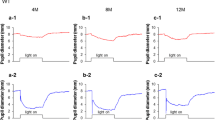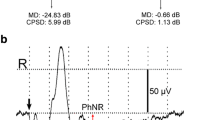Summary
Morphological and functional (ERG) changes in the rabbit eye after beta irradiation with106Ru/106Rh are described. The dorsal part of the eye was irradiated with doses ranging between 2000 and 500,000 rad.
-
1.
After exposure to 20,000 rad sharply limited changes could be detected in the fundus.
-
2.
10,000–20,000 rad produced damage to the visual cells. The most radio-sensitive parts were the outer and inner segments as well as the outer nuclear layer.
-
3.
After exposure to 50,000–100,000 rad all cells including the big ganglious cells were found destroyed.
-
4.
After doses higher than 20,000 rad a reduction of theb-wave amplitude could be found.
-
5.
In order to study the influence of betarays on the ERG additional experiments were made on the isolated rabbit retina using the method worked out byHanitzsch. An exposure to 10,000 rad surface dose resulted in a reduction of theb-wave.
-
6.
After 20,000 rad we found an edema of the choroid as an immediate reaction and a complete choroid atrophy as a late effect.
-
7.
Even after such high doses as 500,000 rad we never found a perforation of the bulb although radiogenic necroses of the sclera had developed.
The experiments showed, that it is possible to apply very high doses of betarays to a part of the bulb without causing radiogenic destruction of the whole bulb. There is a sharp boundary between radionecrosis and normal tissue. This seems of practical value for the treatment of the tumors.
Zusammenfassung
Morphologische und funktionelle (ERG) Veränderungen des Kaninchenauges durch Betabestrahlung des dorsalen Augenabschnittes mit einem106Ru/106Rh-Applikator nach abgestuften Strahlendosen von 2000–500000 rad Oberflächendosis werden beschrieben.
-
1.
Nach 20000 rad ließen sich ophthalmoskopisch scharf begrenzte bleibende Veränderungen am Augenhintergrund nachweisen.
-
2.
10000–20000 rad führten zu Zerstörungen der Netzhautzellen, wobei sich die Außen- und Innenglieder sowie die äußeren Körnerzellen als die strahlenempfindlichsten Gebilde erwiesen.
-
3.
Nach 50000–100000 rad waren im Gebiet der Strahleneinwirkung alle cellulären Elemente der Netzhaut einschließlich der großen Ganglienzellen zerstört.
-
4.
Nach einer Dosis größer als 20000 rad ließen sich im ERG bleibende Defekte in Form einer Verkleinerung derb-Wellenamplitude nachweisen.
-
5.
Der Einfluß von Betastrahlen auf das ERG wurde ergänzend durch Bestrahlungsversuche an der isolierten Kaninchennetzhaut nach der Methode vonHanitzsch untersucht. Dabei kam es nach einer Dosis von 10000 rad zurb-Wellenreduktion.
-
6.
20000 rad bewirken an der Aderhaut als Frühreaktion ein Ödem, als Spätreaktion eine vollständige Aderhautatrophie.
-
7.
Auch nach hohen Dosen bis 500000 rad entsteht trotz einer radiogenen Skleranekrose keine Bulbusperforation.
Die Versuche haben gezeigt, daß sich mit Betastrahlen sehr hohe Strahlendosen auf einen Teil des Augapfels applizieren lassen, ohne daß der Bulbus radiogen zerstört wird. Es besteht eine scharfe Grenze zwischen Strahlennekrose und normalem Gewebe. Dies erscheint für die Tumorbehandlung von praktischer Bedeutung.
Similar content being viewed by others
Literatur
Bachofer, C. S., andS. E. Wittry: (1) Comparison of stimulus energies required to alicit the ERG in response to x-rays and to light. J. gen. Physiol.46, 177–187 (1962).
— (2) Off-response of electroretinogram induced by x-ray stimulation. Vision Res.3, 51–59 (1963).
— (3) Interactions of x-rays and light in the production of the electroretinogram. Exp. Eye Res.2, 141–147 (1963).
— (4) Immediate retinal response to x-rays at milliroentgen levels. Radiat. Res.18, 246–254 (1963).
Baily, N. A., andW. K. Noell: Relative biological effectiveness of various qualities of radiation as determined by the electroretinogram. Radiat. Res.9, 459–468 (1958).
Becher, H., u.H. Themann: Feinstrukturelle Untersuchungen über die Röntgenstrahlenwirkung in der Retina vom Meerschweinchen. Z. mikr.-anat. Forsch.71, 587–608 (1964).
Birch-Hirschfeld, A.: Die Wirkung der Röntgen- und Radiumstrahlen auf das Auge. Albrecht v. Graefes Arch. Ophthal.59, 229–310 (1904).
— Weiterer Beitrag zur Wirkung von Röntgenstrahlen auf das menschliche Auge. Albrecht v. Graefes Arch. Ophthal.66, 104–119 (1907).
Chalupecky, H.: Über die Wirkung der Röntgenstrahlen auf das Auge und die Haut. Zbl. prakt. Augenheilk.21, 234–243, 267–271 (1897).
Cibis, P. A., andD. V. L. Brown: Retinal changes following ionizing radiation. Amer. J. Ophthal.40, 84–88 (1955).
—,W. K. Noell, andB. Eichel: Ocular effects produced by high-intensity x-radiation. Arch. Ophthal.53, 651–663 (1955).
Dowling, J. E., andR. L. Sidman: Inherited retinal dystrophy in the rat. J. Cell Biol.14, 73–109 (1962).
Fossati, Fr.: Die Behandlung von Retinoblastomen und Melanoblastomen der Uvea mit Implantation radioaktiver Kobaltdrähte. Strahlentherapie124, 180–197 (1964).
Freundlich, H. F.: A new beta-ray applicator using fission products. Nature (Lond.)164, 308–310 (1949).
Geeraetz, W. J.: Untersuchungen zur Deutung von Netzhautverbrennungen. Albrecht v. Graefes Arch. Ophthal.165, 452–463 (1963).
Hamberger, A., B. D. H. Rosengren, andB. Tengroth: Radiation studies on the retina. Acta ophthal. (Kbh.)42, 951–956 (1964).
Hanitzsch, R., u.H. Bornschein: Spezielle Überlebensbedingungen für isolierte Netzhäute verschiedener Warmblüter. Experientia (Basel)21, 484 (1964).
— u.A. L. Bysov: Methodische Voraussetzungen zur Ableitung mit Mikroelektroden an der isolierten menschlichen Netzhaut. Vision Res.3, 207–212 (1963).
Haye, C., M. A. Dollfus, etH. Jammet: Traitement des métastases chorioidiennes par les disques radioactifs de Stallard. Bull. Soc. franç. Ophthal.79, 553–556 (1966).
Hegewald, H., u.P. Lommatzsch: Strahlenschutzprobleme bei der Anwendung radioaktiver Nuklide in der Ophthalmologie. Klin. Mbl. Augenheilk.146, 76–86 (1965).
Hicks, S. P., andP. G. B. Montgomery: Effects of acute radiation on the adult mammalian central nervous system. Proc. Soc. exp. Biol. (N. Y.)80, 15 (1952).
Kent, S. P., andA. A. Swanson: Effects of high-intensity x-irradiation on the retina: a histological, histochemical and chemical study in the rabbit. Radiat. Res.6, 111–120 (1957).
Kunz, J., u.P. Lommatzsch: Veränderungen des S35-Einbaues in die Sklera von Kaninchenaugen nach hochdosierter Betabestrahlung. Albrecht v. Graefes Arch. klin. exp. Ophthal.171, 68–76 (1966).
Lebedinskij, A. V., J. G. Grivorev, u.G. G. Demirčogljan: Über die biologische Wirkung kleiner Dosen ionisierender Strahlung. Kernenergie4, 377–385 (1959).
Lederman, M.: Some applications of radioactive isotops in ophthalmology. Brit. J. Radiol.29, 1–13 (1956).
—: Technique of radiation. A treatment of orbital tumours. Brit. J. Radiol.30, 469–476 (1957).
—: Radiotherapy of non-malignant diseases of the eye. Brit. J. Ophthal.41, 1–19 (1957).
—: Radiotherapy of cancerous and precancerous melanosis. Trans. Ophthal. Soc. U.K.78, 147–164 (1958).
Lommatzsch, P., u.R. Vollmar: Ein neuer Weg zur konservativen Therapie intraokularer Tumoren mit Betastrahlen (Ru106/Rh106) unter Erhaltung der Sehfähigkeit. Klin. Mbl. Augenheilk.148, 682–699 (1966).
Müller-Limmroth, W.: Elektrophysiologie des Gesichtssinns, S. 180. Berlin-Göttingen-Heidelberg: Springer 1959.
Newell, F. W., O. Choi, N. A. Book, P. V. Harper, andA. Simkus: Focal ionizing radiation of the posterior ocular segment. Amer. J. Ophthal.50, 1215–1225 (1960).
—,P. V. Harper, andA. Koistenen: Irradiation of the posterior ocular segment with radioactive yttrium. Amer. J. Ophthal.42, 85–88 (1956).
Noell, W. K.: (1) The origin of the electroretinogram. Amer. J. Ophthal.38, 78–90 (1954).
— (2) Differentiation, metabolic organization, and viability of the visual cell. Arch. Ophthal.60, 702–733 (1958).
— X-Irradiation studies on the mammalian retina. Response to the nervous system to ionizing radiation, p. 543–559. New York: Academic Press Inc. 1962.
Pilz, A., u.M. Maesz: Bildung und Bewertung der Seitendifferenz im klinischen ERG. Klin. Mbl. Augenheilk.141, 357–365 (1962).
Reese, A. B.: (1) Tumors of the eye, sec. ed. New York: Hoeber Medical Division 1963.
—: (2) Frequency of retinoblastoma in the progeny of parents who have surrived the disease. Arch. Ophthal.52, 815–818 (1954).
— (3) The diagnosis and treatment of retinoblastoma. Acta Soc. ophthal. Jap.62, 2174–2184 (1958).
Rohrschneider, W.: Experimentelle Untersuchungen über die Veränderungen normaler Augengewebe nach Röntgenbestrahlung. I. II. Mitt. Albrecht v. Graefes Arch. Ophthal.121, 626–559 (1929); III. Mitt.122, 282–298 (1929); IV. Mitt.122, 382–390 (1929).
Schober, H.: Die Direktwahrnehmung von Röntgenstrahlen durch den menschlichen Gesichtssinn. Vision Res.4, 251–269 (1964).
Sickel, W., H. G. Lippmann, W. Haschke, u.Ch. Baumann: Elektroretinogramm der umströmten menschlichen Retina. Dtsch. ophthal. Ges.63, 316–318 (1961).
Stallard, H. B.: Retinoblastoma treated by radon seeds and radioactive discs. Ann. roy. Coll. Surg. Engl.16, 349–366 (1955).
—: Malignant melanoma of the choroid treated with radioactive applicators. (1) Trans. ophthal. Soc. U.K.79, 373–392 (1960).
—. (2) Ann. ophthal. roy. Coll. Surg. Engl.29, 170–182 (1961).
—: The irradiation of retinoblastoma. Trans. ophthal. Soc. U.K.80, 589–595 (1961).
—: The conservative treatment of retinoblastoma. Trans. ophthal. Soc. U.K.82, 473–535 (1962).
Tribondeau, L., etG. Belley: Microphtalmie et modifications concomitantes de la rétine par irradiation par les rayons x de l'œil d'animaux nouveannés. C. R. Soc. Biol. (Paris)63, 128–130 (1907).
Vogel, H. H.: Retinal damage and cataract formation following x-irradiation of the heads of newborn mice. Progr. Rep. ANL-4676, Biological and Medical Research Division 1951, p. 29–40.
Author information
Authors and Affiliations
Rights and permissions
About this article
Cite this article
Lommatzsch, P. Morphologische und funktionelle Veränderungen des Kaninchenauges nach Einwirkung von Betastrahlen (106Ru/106Rh) auf den dorsalen Bulbusabschnitt. Albrecht von Graefes Arch. Klin. Ophthalmol. 176, 100–125 (1968). https://doi.org/10.1007/BF02385041
Received:
Issue Date:
DOI: https://doi.org/10.1007/BF02385041




